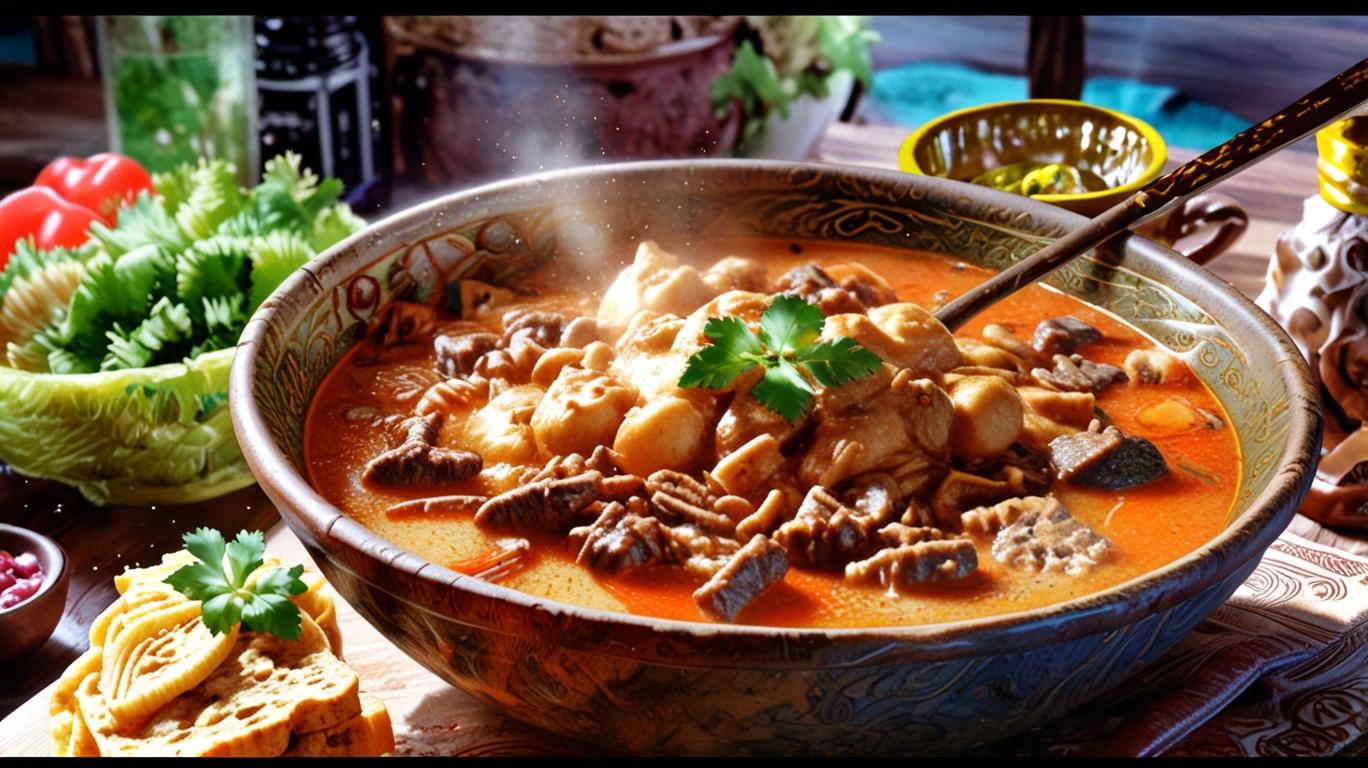Unlock the Secret to Cambodia’s Richest Curry – The Ancient Dish You’ve Never Heard Of!
Discover How This Hidden Cambodian Gem Brings Flavor, Culture, and History Together in One Pot!

Recipe Index
- Fish Amok
- Lok Lak (Stir-fried Beef)
- Nom Banh Chok (Khmer Noodles)
- Samlor Korko (Stirring Pot Soup)
- Beef Saraman Curry
- Char Kroeung Sach Ko (Stir-fried Lemongrass Beef)
- Bai Sach Chrouk (Pork and Rice)
- Kuy Teav (Noodle Soup)
- Prahok Ktis (Pork and Coconut Dip)
- Num Ansom Chek (Banana Sticky Rice Cake)
- Lap Khmer (Lime-marinated Khmer Beef Salad)
- Char Kdav (Caramelized Palm Sugar Chicken)
- Maam Snoul (Fermented Fish)
- Nom Kong (Khmer Donuts)
- Twa Ko (Khmer Sausage)
NOW!
Imagine a curry so rich and flavorful that it’s been a well-guarded secret among Cambodia’s Cham community for centuries.
Beef Saraman Curry isn’t just a dish; it’s a culinary treasure, offering a taste of history and culture with every bite. This isn’t your everyday curry—this is the real deal, packed with spices, tender beef, and the smoothest coconut milk, simmered to perfection.
Ready to dive into a world of bold flavors and learn how to create a dish that will leave everyone asking for seconds?
Beef Saraman Curry (ការីសារ៉ាម៉ាន់)
Overview
Beef Saraman Curry, also known as Cari Saramann, is a rich, flavorful dish that showcases the Muslim influences in Cambodian cuisine. This aromatic curry is characterized by its use of dry spices, coconut milk, and tender beef, creating a dish that’s both comforting and exotic.
Cultural Significance
Historical Context
Saraman Curry reflects the cultural diversity of Cambodia, particularly the influence of the Cham Muslim minority. It’s believed to have roots in Malaysian and Indonesian cuisine, adapted over time to Khmer tastes and ingredients.
Regional Importance
While enjoyed throughout Cambodia, Saraman Curry is particularly associated with the Cham communities in Kampong Cham province. In Siem Reap, it represents the rich tapestry of culinary traditions that make up Cambodian cuisine.
When It’s Eaten
Beef Saraman Curry is often prepared for special occasions and celebrations within the Cham community. In Siem Reap’s restaurants, it’s becoming increasingly popular as tourists seek out diverse Cambodian dishes beyond the more common offerings.
Key Information
- Preparation Time: 30 minutes
- Cooking Time: 2 hours
- Total Time: 2 hours 30 minutes
- Difficulty Level: Medium to Complex
- Servings: 6
Ingredients
For the curry paste:
- 8-10 dried red chilies, soaked and deseeded
- 1/2 cup chopped shallots
- 4 cloves garlic
- 2 stalks lemongrass, white part only, chopped
- 2 tbsp chopped galangal
- 2 tsp turmeric powder
- 1 tsp coriander seeds
- 1 tsp cumin seeds
- 1/2 tsp cardamom seeds
- 2 star anise
- 1 cinnamon stick, broken
- 3 cloves
For the curry:
- 1 kg beef chuck, cut into 2-inch cubes
- 3 tbsp vegetable oil
- 2 cups coconut milk
- 2 cups beef broth
- 3 tbsp fish sauce
- 2 tbsp palm sugar
- 1/2 cup roasted peanuts, ground
- 3 kaffir lime leaves
- 1 tbsp tamarind paste
For serving:
- Steamed rice
- Fresh coriander leaves
- Lime wedges
Notes on Ingredients
- Dried spices can be found at the Old Market (Psar Chas) in Siem Reap.
- If palm sugar is unavailable, brown sugar can be used as a substitute.
Instructions
Preparing the curry paste:
- Dry roast the coriander seeds, cumin seeds, cardamom seeds, star anise, cinnamon, and cloves in a pan until fragrant. Cool and grind to a powder.
- In a food processor or using a mortar and pestle, blend the ground spices with the remaining curry paste ingredients to form a smooth paste.
Cooking the curry:
- Heat oil in a large pot over medium heat. Add the curry paste and fry for 5-7 minutes until fragrant and the oil separates.
- Add the beef cubes and stir to coat with the paste. Cook for 5 minutes, stirring occasionally.
- Pour in the coconut milk and beef broth. Bring to a boil, then reduce heat to low and simmer for 1.5 to 2 hours, or until the beef is tender.
- Stir in fish sauce, palm sugar, ground peanuts, kaffir lime leaves, and tamarind paste.
- Simmer for another 15-20 minutes until the sauce thickens.
Serving:
- Taste and adjust seasoning if necessary.
- Serve hot with steamed rice.
- Garnish with fresh coriander leaves and lime wedges.
Serving Suggestions
- Traditionally served with steamed rice to soak up the rich sauce.
- Some enjoy it with a side of pickled vegetables for contrast.
Beverage Pairings
- Non-alcoholic: Thai iced tea or a mango lassi complement the rich flavors well.
- Alcoholic: A full-bodied red wine like Syrah or a craft IPA can stand up to the bold flavors.
Nutritional Information
- Calories: Approximately 550 per serving
- Protein: 35g
- Carbs: 20g
- Fats: 40g
- High in vitamins and minerals from the diverse spices and coconut milk
Variations
Regional Differences
- Some versions include potatoes or sweet potatoes for added texture.
- In coastal areas, you might find seafood variations of Saraman Curry.
Modern Adaptations
- Vegetarian versions replace beef with tofu or mixed vegetables.
- Some chefs in Siem Reap are experimenting with fusion versions, incorporating local Cambodian ingredients.
Cultural Notes
- The name “Saraman” is believed to derive from “Suleiman,” reflecting its Muslim origins.
- This curry is often compared to Malaysian rendang, showcasing the culinary connections in Southeast Asia.
Chef’s Tips
- For the best flavor, make the curry paste from scratch. The aroma of freshly ground spices is unbeatable.
- Don’t rush the cooking process. Slow simmering allows the beef to become tender and the flavors to meld.
- Adjust the number of chilies in the paste to control the heat level of your curry.
Related Experiences
- “Spice Market Tour” in Siem Reap, exploring the various spices used in Khmer cuisine.
- Cooking class focused on Cambodian curries at a local culinary school.
- Visit to a Cham community near Siem Reap to learn about their culinary traditions.
Editor’s Note: Beef Saraman Curry isn’t just a recipe—it’s a story on a plate. Every ingredient, from the rich coconut milk to the fragrant spices, tells a tale of Cambodia’s diverse culinary heritage. This is more than food; it’s an experience that transports you to the heart of Khmer culture. As you explore this dish, think about the hands that passed down this recipe through generations, each one adding their unique touch. Get ready to impress not just with flavor, but with the history and culture behind it.
Key Takeaways:
A Taste of Cambodia’s Diversity:
Saraman Curry is a flavorful example of how Cambodian cuisine is shaped by various cultural influences, particularly from the Cham Muslim community. Each bite connects you to a broader world of tastes and traditions.A Recipe Rooted in History:
This dish is a culinary snapshot of the historical ties between Cambodia, Malaysia, and Indonesia, adapted to Khmer flavors over the centuries. It’s like eating a piece of Southeast Asian history!A Special Dish for Special Occasions:
Originally served during significant celebrations, Beef Saraman Curry is a treat that carries the essence of festivity and communal gatherings. When you make this dish, you’re not just cooking—you’re celebrating.Slow-Cooked Perfection:
The key to this curry’s deep, rich flavor lies in the slow simmering process, which allows the beef to become tender and the spices to meld into a perfect harmony. Patience in cooking brings rewards on the plate!The Power of Fresh Spices:
Grinding your own spices elevates the dish to a whole new level, making the flavors more vibrant and authentic. It’s worth the extra effort for an aroma that’s simply unbeatable.Versatility in a Bowl:
While traditionally made with beef, Saraman Curry can be adapted to suit different tastes, including vegetarian options with tofu or vegetables. It’s a dish that welcomes everyone to the table.A Connection to the Cham Community:
Saraman Curry is more than just a meal—it’s a connection to Cambodia’s Cham community and their rich cultural heritage. Sharing this dish is a way of sharing their story.Fusion Flavors for a Modern Twist:
Some chefs in Siem Reap are blending traditional Cambodian ingredients with the classic Saraman Curry recipe, creating exciting new fusion dishes that still honor the original’s deep flavors.Pair It Right:
Whether you’re enjoying it with a refreshing mango lassi or a bold red wine, the right drink can take this dish to the next level. It’s all about finding the perfect match for those intense flavors.Cooking Class Fun:
Why just taste Saraman Curry when you can learn to make it yourself? Cooking classes in Siem Reap offer hands-on experiences that bring you closer to Cambodian culture, one spice at a time.The Spice Market Adventure:
Take a journey through a spice market in Siem Reap and discover the ingredients that make Saraman Curry so special. It’s a flavorful adventure that’s as much about the journey as it is about the destination.A Dish with Many Faces:
Depending on where you are in Cambodia, you might find different takes on Saraman Curry, from seafood variations to modern interpretations. It’s a dish that evolves with its surroundings.Sweet and Spicy Balance:
The combination of coconut milk and dry spices creates a unique balance of sweet and spicy, making each bite of Saraman Curry a dance of flavors on your tongue.Learn from the Locals:
Visiting a Cham community offers the chance to see how this dish is prepared traditionally, giving you insights that go beyond the recipe. It’s cooking with a story attached.Why It’s a Must-Try:
Whether you’re a seasoned foodie or just someone who loves a good meal, Beef Saraman Curry is a must-try for its rich flavors, historical significance, and the warmth it brings to the table.
Featured
Explore more on My Siem Reap Tours
Koh Ker and Beng Mealea guided tour | Banteay Srei temple tour semi-private guided tour | Angkor Wat Sunrise shared tour | Koh Ker and Beng Mealea guided tour | Morning Siem Reap floating village tour | Afternoon Siem Reap floating village tour | Private Angkor Wat special tour | Kulen Waterfall small group guided Tour | Private Angkor Wat mix temples photo tour













